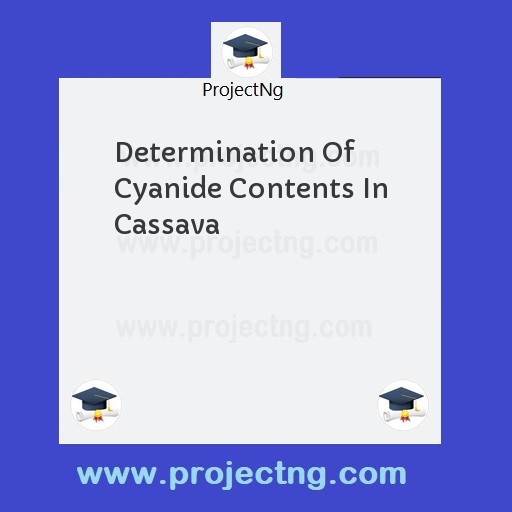Determination Of Cyanide Contents In Cassava
Science Lab Technology Project Topics
Get the Complete Project Materials Now! »
DETERMINATION OF CYANIDE CONTENTS IN CASSAVA
Abstract
The cyanide Levels in two cassava varieties and some derived products was investigated. The study was conducted on fresh tubers by, sampling in three longitudinal positions (1/4: ½: ¾) and four radials (A, B, C and D). In addition the sampling of derived products was carried out by product types (chip dried, Garri and flour). Cyanide Contents were determined. Results showed that whatever the variety considered, there was no significant difference between the total HCN content in cassava slices (1/4; ½ ; ¾ ). Similarly, results from different layers did not highlight radial variability of the total HCN content. The variable cyanide content (MgHCN/kg fresh material) in cassava varieties showed:104.3 ±3.9;171.6±5.4 for Kombo and Nwangbisi respectively. The detoxification processes (gari and flour) indicated a reduction rate in excess of 80% and may be effective to reduce cyanide content in cassava root down to a tolerable level (< 50mgh/kg).
TABLE CONTENT
Title Page i
Certification ii
Dedication iii
Abstract iv
Table of content v
CHAPTER ONE
1.1 Introduction 1
1.2 Aim of the study 3
1.3 Statement of problem 3
1.4 Significance of the study 4
1.5 Limitations of the study 5
CHAPTER TWO
2.0 Literature Review 6
2.1 Cyanide toxicity 6
2.2 Effect of Chronic exposure to cyanigenic glycoside containing food stuffs 7 2.3 Biochemical basis for Cyanide poisoning 8
2.4 Cyanide as plant defence mechanism 10
2.5 Methods for reducing or elementary Cyanide Exciting 11
CHAPTER THREE
3.0 Experimental Design 13
3.2 Preparation of derived products 13
3.3 Samples preparation and Cyanide measurements 15
CHAPTER FOUR
Results and Discussion
4.1 Total Cyanide contents in cassava slices and varities 20
4.2 Total Cyanide contents in Cassava layers 22
4.3 Cyanide contents in cassava and some derived products 24
CHAPTER FIVE
5.1 Conclusion 27
5.2 Recommendation 28
Reference 29
CHAPTER ONE
1.1 INTRODUCTION
Cassava (Manihot esculenta) is an extensively cultivated tuber crop and a staple food for millions of people in the tropical regions of Africa, Latin America and Asia. Globally, in terms of annual production, it is the fifth most important food crop after maize, rice, wheat and potato. Despite all the usefulness of cassava, its use as a food source is limited by its perishability, its low protein content and its potential toxicity. Cassava contains two cyanogenic glucosides, linamarin and a small amount of Lotaustralin, which are catalytically hydrolyzed to release toxic hydrogen cyanide (HCN) when tine plant tissue is crushed. Several varieties of cassava have been identified and grouped into bitter and sweet depending on the quantity of Linamarin in the tuber. The consumption of cassava and its derived products which contain Large amounts of HCN may be responsible for such visible manifestations as goiter and cretinism, tropical ataxic neuropathy,(Bradbury, 2004).
In some countries such as cote d’ivoire, Benin and Nigeria, people have quickly recognized the need to transform cassava into derived products (fufu, Garri, Tapioca) whose gain is usually higher than the fresh roots. The processing methods used traditionally are sun drying, soaking and fermentation followed by cooking. These processing methods could lead to reduce the cyanide content in cassava products to improve its palatability and convert it into a storable form, Ernesto et al, (1998).
The aim of this study was to estimate the rate of cyanide in three cassava varieties and assess some cassava detoxification processes.
1.2 AIM OF THE STUDY
The aim of the study is as follows:
i. To estimate the rate of cyanide in three cassava varieties.
ii. To assess some cassava detoxification processes.
1.3 STATEMENT OF THE PROBLEM.
Liberation of hydrogen HCN and cyanogenic glycosides (CNGs) usually occurs after mastication and ingestion and arises from enzymatic degradation of the Latter to produce HCN. Resulting in acute or chronic cyanide poisoning.
Problems associated with chronic exposure to food containing cyanogenic glycosides (CNGs) have been linked to several diseases primarily affecting the central nervous system. Tropical ataxic neuropathy (TAN) describes several neurological symptoms affecting the mouth. Goitre and cretinism attributed to iodine deficiency can be exacerbated by chronic consumption of inadequately processed cassava. Cyanogenic glycoside are converted to thiocyanate during the detoxification process, which reacts with iodine which is subsequently unavailable to the thyroid, increasing the dietary requirement for iondine these statement prompted the need for a project work on the determination of the amount of Hydrogen cyanide present in cassava which can cause/Lead to poisoning of the system.
1.4 SIGNIFICANCE OF THE STUDY
The result of the project work would reveal hydrogen cyanide (HCN) of cassava. The result would equally reveal if the hydrogen cyanide of cassava was high or low and if the cyanides were poisonous or toxic. And the if the cyanide content is high, then proper detoxification, fermentation and cooking should be encouraged during cassava processing or the consumption of cassava products should be discouraged because of the posionous and toxic effects of hydrogen cyanide in the living system.
1.5 LIMITATIONS OF THE STUDY
The project work is Limited to the Determination of hydrogen cyanide (HCN) in cassava associated with its toxicity. I had a hardicarp in carrying out this project due to low financial status, on my part as a student. The cost of the chemicals for the analysis and some other materials was high, thus limiting the number of sample run for the project work.
Be the First to Share On Social

Enjoying our content?
Don't miss out on new videos! Subscribe to our YouTube channel for more awesome content.
Subscribe Now!













